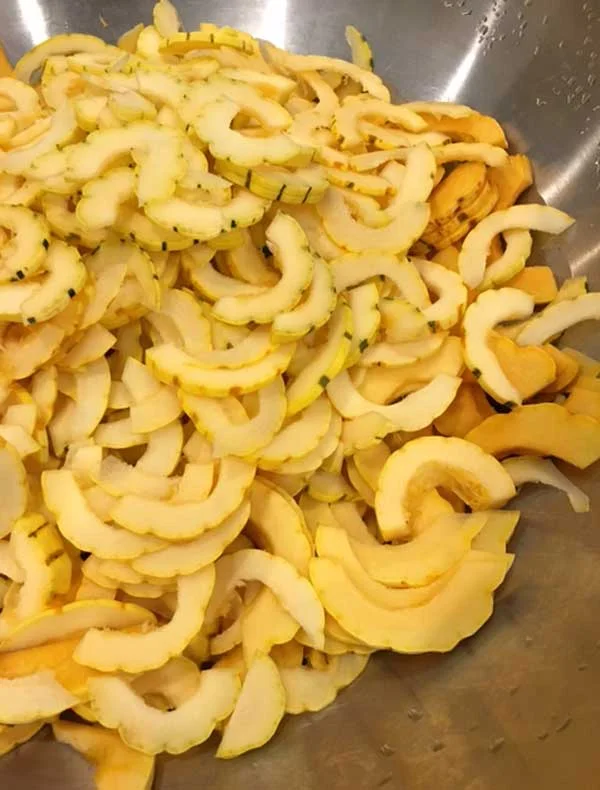Fermented Delicata
Fermenting Winter Squash
wild
: living or growing in the natural environment.
fla·vor
: enhance the taste of (food or drink) by adding a particular ingredient.
The book of the month is WILD FLAVORS, one chef’s transformative year cooking from Eva’s Farm. I purchased this book directly from Eva’s Gardens in Westport, MA on my own exploration of building relationships with as many farmers as I could in order to get closer to my food sources. It’s wonderful to see more chefs and farmers working on so many rich projects. We recently used this book in a nutrition from the ground up workshop to demonstrate how to ferment one of my favorite types of squash:
delicata
: a squash with delicate skin, easy to cut and full of fiber, potassium, vitamin B, C and magnesium. It belongs to the summer squash family, however is consumed the same time of year as winter squash. Delicata squash can be baked, sautéed, steamed, grilled, but in this post we will share a unique way to enjoy this squash throughout the season, fermentation.
Order your own copy of the book + Follow Wild Flavors on Facebook.
Meet Briget Bride, a psychotherapist who has a passion for preserving locallyharvested treasures from farmers and foraging far and wide. She finds ingredients that are in season to bring into her kitchen to play with, making intuitive sauces, jams, syrups and healthy additions. I am so grateful to have her come to The Local Juice for monthly workshops.
Briget has a private practice in the metro south of Boston, since 1993. through her own work she has cemented the belief that the mind and body are one organism that cannot be separated. This naturally includes food, where our food comes from and who grows it. This has fueled her passion for living a healthier more compassionate life by being more connected with nature, people, and how we nourish ourselves. Listen to the workshop or scroll down for easy instructions.
Fermented Delicata Squash
Ingredients
12 whole allspice
3 cinnamon sticks
1 TB whole cloves
1/2 nutmeg
4 onions
4 pounds delicata squash
8 TB sea salt
2 Gallon of water
Instructions
Prepare pumpkin-pie spice mix. Combine allspice, cinnamon sticks, whole cloves and nutmeg. Make the brine: 2 gallon of water, 8 TB sea salt + pumpkin-pie spice.
Sterilize the jars, bands, lids and rocks (see below)
Cool brine to room temperature.
Slice squash in half and remove the seeds.
Thinly slice onions and squash.
Fill jars with layers on onions and squash.
Press down to compress the vegetables and eliminate any spaces between them.
Stop filling jars when there is 2-3 inches from the top.
Pour brine to cover vegetables.
Place rock on top of vegetables an push down.
Screw the lids on the jars.
Let sit at room temperature for 3 days, then move to refrigerator.
Notes: You will have brine leftover, so plan to ferment other winter vegetables. You’ll notice there will be a different texture when you slice the delicata squash thin versus slightly thicker. Both are amazing, so experiment to find your favorite.
By Briget Bride + Nicole Cormier
Adapted from Wild Flavors
sterilize the jars
Wash jars with soap and thoroughly rinse them thoroughly or run them through the dishwasher (with no other items in it but the jars). Place them on a clean cookie sheet/roasting pan, right side up. Then, transfer them to the oven that has been preheated to 230 F where they must be for 20 minutes for sterilization. Cleaning is the first step, sterilization is the second. Remove when time is done and let cool. Cover with plastic wrap if not using right away.
making the brine
We used 8 tablespoons of sea salt + pumpkin-pie spice with 2 gallons of water.
packing your jars
Simply layer onions and squash, but remember to leave 2 – 3 inches from the top.
rocks
Scrub rocks with a brush. Boil rocks for 20 minutes. Put vinegar in the water. Do not use lime stone. Granite is best. Don’t forget to remove rocks from the jars when the flavor you want is achieved.
Note: Press rocks firmly into jars to pack vegetables. Leave the rocks in the jars, place lids on jars and let sit for 3 days at room temperature. Then, move into the refrigerator.












